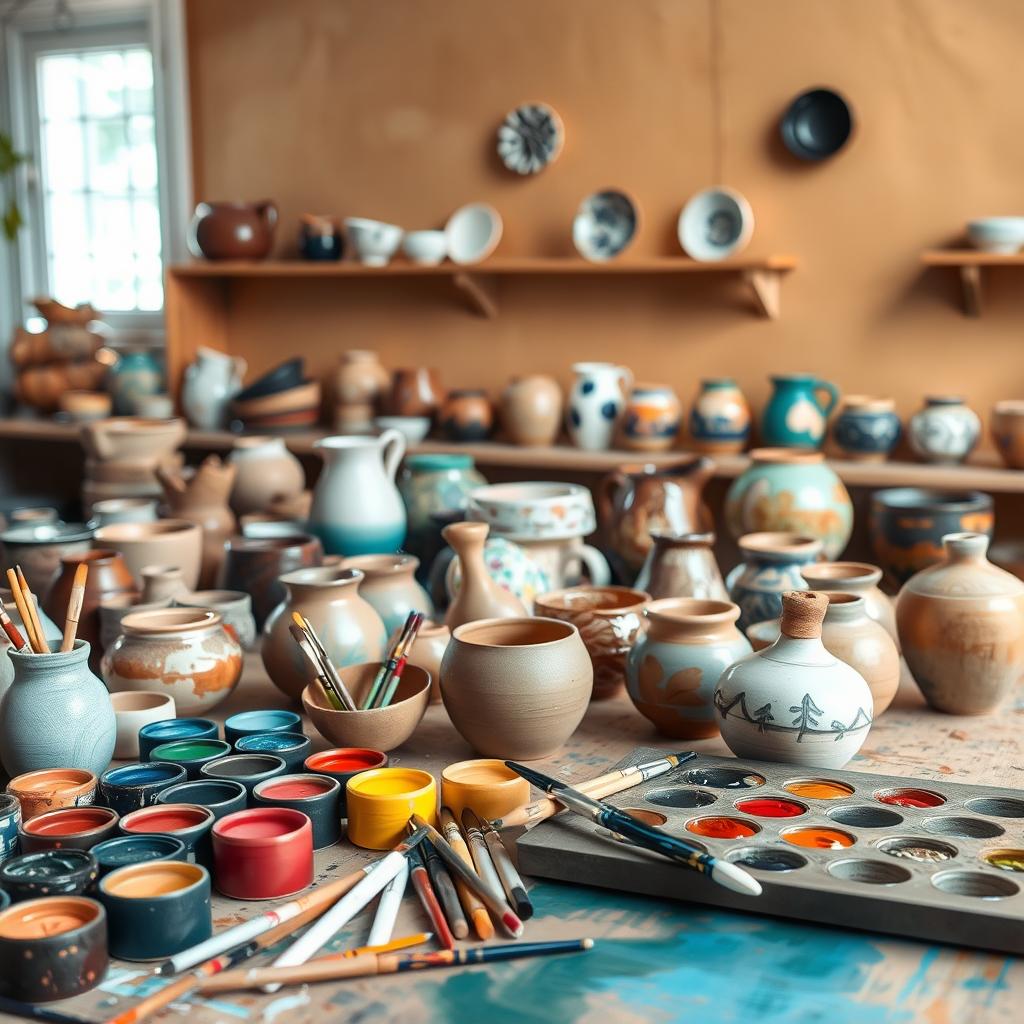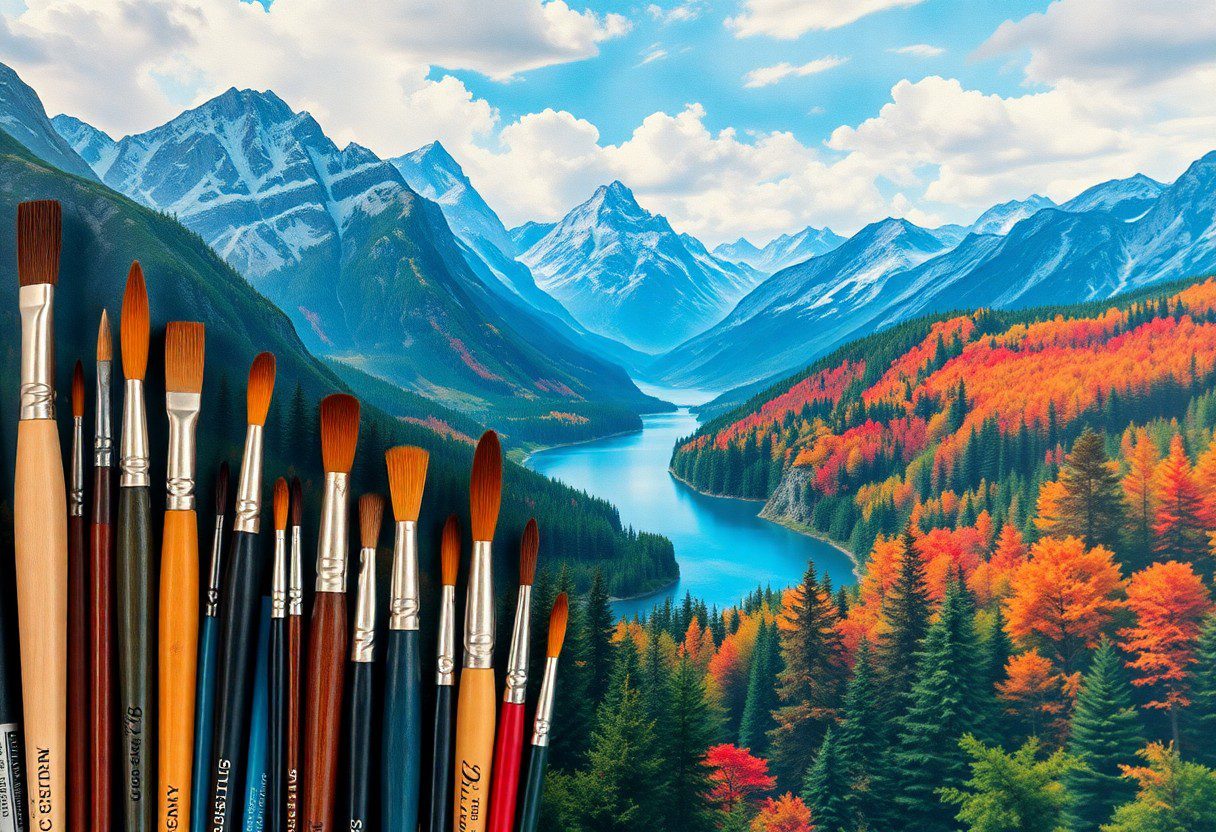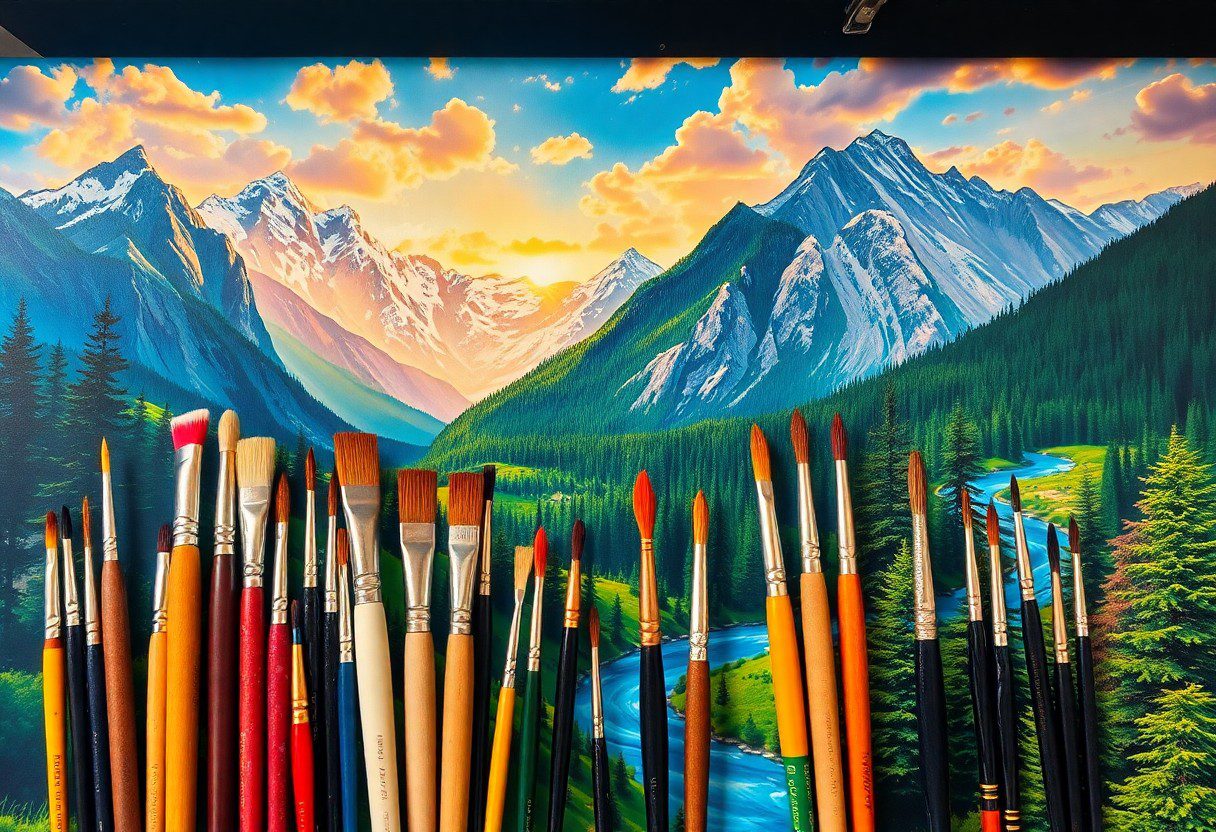You might feel overwhelmed when selecting brushes for your landscape painting projects, but the right tools can elevate your artistry. Understanding the various types of brushes and their specific applications can significantly enhance your creative process. In this guide, we’ll break down the best brush types, shapes, and materials to help you make informed decisions that suit your painting style and techniques. Equip yourself with the knowledge to choose brushes that will bring your landscapes to life and make your artistic vision a reality.
Understanding Brush Types
The selection of brushes in landscape painting greatly influences your artwork. Familiarizing yourself with different brush types will enhance your painting experience. Below is a breakdown of common brush types:
| Brush Type | Typical Use |
|---|---|
| Flat | For broad strokes and covering large areas |
| Round | For detail work and fine lines |
| Filbert | For blending and soft edges |
| Fan | For textures, like foliage |
| Brighter | For defined strokes and mixing |
Any good artist should have a variety of brushes at their disposal to adapt to different techniques and styles.
Different Shapes and Their Uses
For effective landscape painting, understanding the shapes of brushes is necessary. Each shape offers distinct advantages that suit different applications, allowing you to achieve various textures and effects.
Material Comparisons: Natural vs. Synthetic
Even your choice between natural and synthetic bristles plays a significant role in your painting outcomes. Natural brushes typically provide unique textures with better paint holding capacity, while synthetic brushes can be more durable and versatile.
| Material | Features |
|---|---|
| Natural Bristle | Holds more paint, provides unique textures |
| Synthetic Bristle | Durable, easy to clean, versatile |
| Soft Hair | Great for smooth applications (e.g., sable) |
| Stiff Hair | Ideal for thick applications (e.g., hog) |
| Watercolor Brushes | Specifically designed for fluid mediums like watercolors |
Another point to consider is that natural brushes often require more care and can be more expensive than their synthetic counterparts. Balancing quality and budget is necessary, so assess your painting style and frequency to choose what’s best for your practice.
Factors to Consider When Choosing Brushes
Some key factors affect your brush selection for landscape painting. Consider the following:
- Brush material and type
- Brush shape and style
- Brush size and scale
- Your painting technique and style
Knowing these factors will enhance your landscape painting experience.
Brush Size and Scale
On the canvas, the size and scale of your brushes contribute significantly to the overall impact of your artwork. Larger brushes create bold strokes, ideal for background elements, while smaller brushes allow for intricate details and precision. Understanding these aspects helps balance your composition and achieve the desired look.
Painting Technique and Style
With your chosen painting technique and style in mind, it’s vital to select brushes that align with your artistic approach. Whether you favor impasto, glazing, or wet-on-wet techniques, your brush choice can greatly influence the final result.
For instance, if you enjoy a more expressive style with thick textures, opting for filbert or flat brushes will allow you to lay down substantial paint. Conversely, a finer technique may require detail brushes or rounds to capture the delicate features in your landscapes. Adapting your brush selection to your technique can significantly amplify the emotional impact of your paintings.
Tips for Selecting the Right Brushes
Any painter can benefit from these simple tips for selecting the right brushes:
- Consider the type of landscape you are painting.
- Choose brushes made from quality materials.
- Test various shapes and sizes to find your preference.
- Balance durability and flexibility in your choices.
Knowing these factors will help you build a versatile brush collection tailored to your landscape painting needs.
Matching Brushes to Your Subject
Now you need to focus on matching your brushes to your specific subject. Think about the textures and details you want to capture. A flat brush is great for broad strokes and skies, while a round brush is perfect for intricate details in trees and foliage. Consider the weight and flow of your paint as well, as this can impact the brush type you choose for different elements in your composition.
Testing Brushes Before You Commit
Commit to experimenting with various brushes before making a purchase decision. You should try out brushes at art supply stores or borrow from fellow artists to see how they feel in your hand. Don’t hesitate to pay attention to how they respond to your painting style and medium, as this can differ significantly depending on the brush’s design.
To ensure you find the perfect brushes for your landscape painting, test a range of options on practice canvases. Use different strokes and techniques to observe how each brush behaves with your chosen mediums. This hands-on approach allows you to gauge the ease of movement, control, and even the final finish each brush delivers. By investing time in testing, you can make informed choices that align with your artistic vision and enhance your painting experience.
Maintaining Your Brushes for Longevity
After investing in quality brushes for your landscape painting, it’s imperative to take care of them properly to ensure their longevity. Regular maintenance not only preserves their shape and integrity but also enhances your painting experience. With the right cleaning techniques and storage recommendations, you can keep your brushes in top condition for years to come.
Proper Cleaning Techniques
Clearly, the way you clean your brushes can significantly impact their lifespan. Use lukewarm water and a gentle soap to remove paint from bristles, taking care to avoid bending or twisting them. Rinse thoroughly and reshape the bristles before setting them aside to dry completely, ensuring they maintain their original form.
Storage Recommendations
Your brushes need a safe space after use to protect their bristles and maintain their shape. Avoid storing them flat, which can cause bristles to splay or become misshapen. Instead, consider upright storage in a holder or container to keep them organized and easily accessible while also preserving their integrity for future projects.
The ideal storage solution involves using brush holders or jars, keeping the bristles upright and separated. This prevents the brushes from rubbing against one another, which can lead to fraying or damage. Additionally, storing them in a cool, dry environment away from direct sunlight extends their life, allowing you to enjoy using them for many landscapes to come.
Common Mistakes to Avoid
Unlike what many beginners think, choosing brushes for landscape painting is not simply about selecting the ones that look attractive. This is where many artists go wrong; they often overlook the practical aspects of brush functionality. It’s vital to avoid settling for the first brushes you find or picking them solely based on their appearance. Such choices can impact your ability to create depth, texture, and details in your landscapes.
Overlooked Brush Characteristics
On your journey to mastering landscape painting, don’t underestimate the importance of brush characteristics such as bristle stiffness, shape, and size. Each feature contributes significantly to how paint interacts with your canvas. For instance, a stiff bristle brush may serve well for heavy textures, while a softer brush can create delicate washes. Understanding these nuances sets the groundwork for achieving desired effects in your artwork.
Misjudging Brush Quality
Brush quality significantly impacts your artwork, and misunderstanding this can lead to frustration and subpar results. When purchasing brushes, you may be inclined to choose lower-priced options, but this can be a false economy. Investing in higher-quality brushes makes a noticeable difference in how paint applies and blends on the canvas.
It’s not just about the price tag; look for brushes made from good materials that hold their shape and allow for precise control. Quality brushes are more durable and can handle various painting techniques, giving you the freedom to experiment. They also provide better paint retention, which translates to smoother strokes and improved detail in your landscapes.
Additional Resources and Tools
Once again, having the right resources at your disposal can help you elevate your landscape painting skills. Consider investing in quality instructional books, online courses, and video tutorials that focus specifically on brush techniques and landscape painting styles. Additionally, keeping a sketchbook handy for practice can greatly enhance your understanding of composition and color application. These tools will foster your growth as an artist, ultimately enriching your landscape pieces.
Recommended Brands
Tools matter, and choosing the right brushes can make a significant difference in your landscape painting practice. Brands like Winsor & Newton, Da Vinci, and Escoda offer a wide variety of high-quality brushes specifically designed for different strokes and applications. When opting for brushes, look for those that cater to your preferred medium, whether it be oils, acrylics, or watercolors, to ensure you achieve the best results.
Online Communities and Forums
If you’re looking to connect and share with other artists, online communities and forums can be invaluable. These platforms allow you to ask questions, seek advice, and gain insight from fellow landscape painters, no matter your skill level.
This sense of community can provide you with inspiration and support as you explore various techniques and styles. By actively participating in these forums, you can learn about new brushes, share your experiences, and even receive constructive feedback on your work. Engaging with others will deepen your understanding of landscape painting and enhance your journey as an artist.
Summing up
Presently, choosing the right brushes for landscape painting involves understanding the types of brushes available and how they can enhance your technique. You should consider the size, shape, and material of each brush to achieve the desired effects in your work. Experimenting with different brushes will help you find what best suits your style and the landscapes you wish to capture. With your newfound knowledge, you can make informed decisions that will elevate your landscape painting experience.
FAQ
Q: What types of brushes are best for landscape painting?
A: When identifying brushes for landscape painting, it’s advisable to consider a variety of brush types. Flat brushes are excellent for broad strokes, covering large areas quickly. Angle brushes can help create sharp edges and details. Round brushes are versatile and can be used for both details and washes. Additionally, fan brushes are great for texture and foliage representation. A combination of different brush shapes will give you more flexibility and creativity in your landscape works.
Q: How do brush sizes impact my landscape painting?
A: Brush sizes play a significant role in achieving different effects. Larger brushes are ideal for blocking in big areas of color and sky, while smaller brushes are better for detailing elements such as trees, mountains, and small accents. It’s helpful to use a range of sizes; for instance, a 1-inch flat brush for large skies and a size 2 round brush for tree branches ensures that both broad washes and intricate details can be effectively executed.
Q: Should I choose synthetic or natural bristle brushes for painting landscapes?
A: The choice between synthetic and natural bristle brushes often comes down to personal preference and the specific effects you want to achieve. Natural bristles, like those from hogs or sable, tend to hold more paint and provide a softer application, which can be great for blending and smooth finishes. On the other hand, synthetic brushes are usually more affordable, durable, and easy to clean, making them suitable for a variety of painting mediums. Experimenting with both types can help you determine which best aligns with your painting style.
Q: How can I maintain my brushes for long-lasting use in landscape painting?
A: Proper brush maintenance is key to longevity and performance. Clean your brushes immediately after use with soap and warm water or a suitable brush cleaner. Avoid letting paint dry on the bristles, as this can lead to damage. Reshape the bristles while wet and store them vertically or flat to maintain their form. For brushes with natural bristles, you might occasionally condition them with a small amount of brush soap to keep them supple. Following these steps will help preserve the quality and functionality of your brushes.
Q: What features should I look for in a brush handle for landscape painting?
A: When identifying brushes for landscape painting, consider the handle length and material. Longer handles can provide better leverage for sweeping strokes, which can be beneficial for larger canvases. Short handles, however, are often easier to control for detailed work. Look for handles made from sturdy wood or acrylic; they should feel comfortable in your hand during extended painting sessions. Lastly, ensure the grip is not too slippery, as this could affect your control and precision when painting diverse landscapes.





